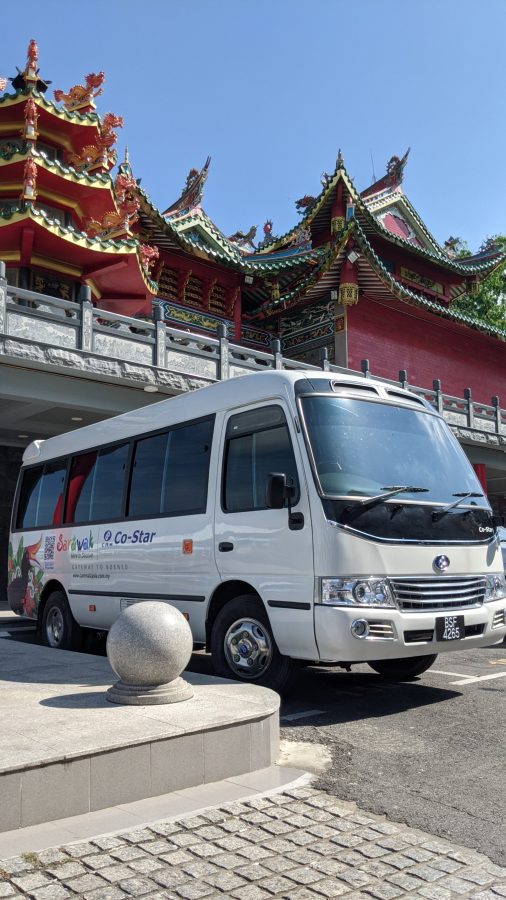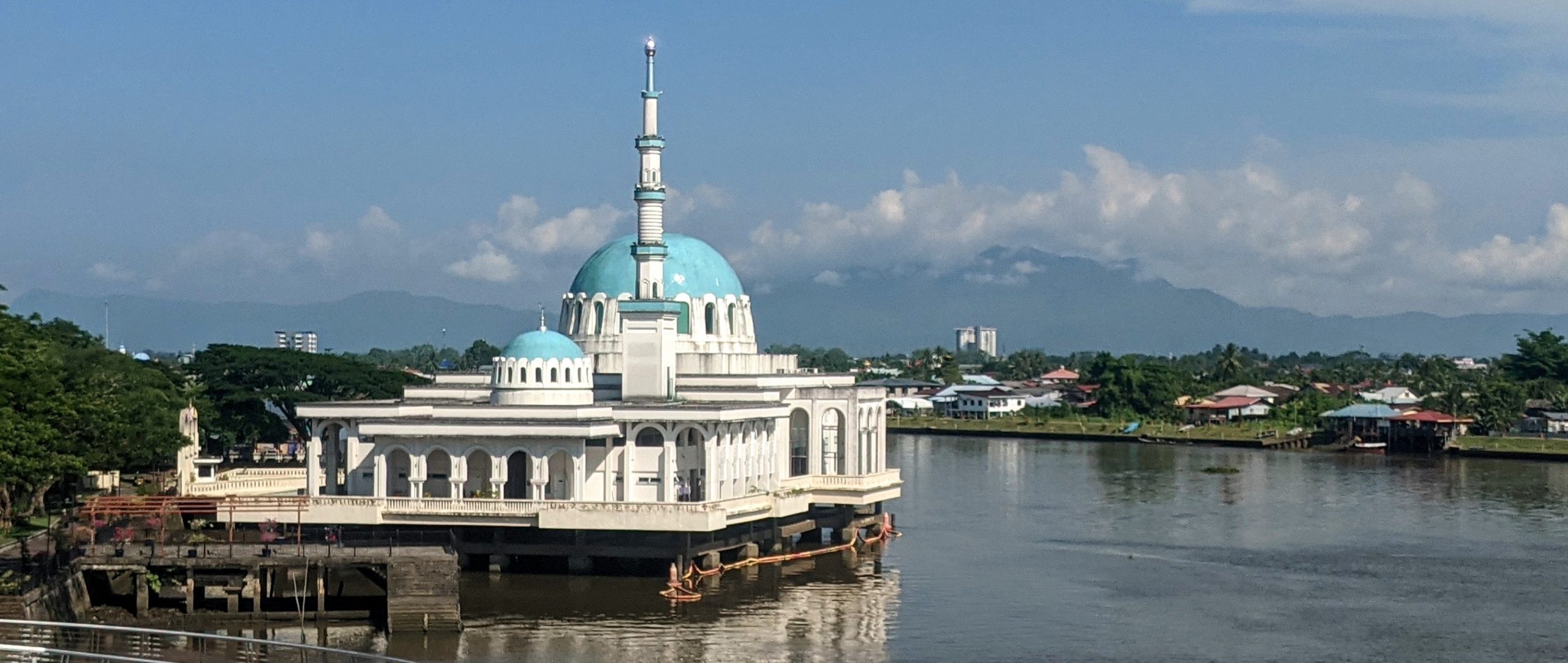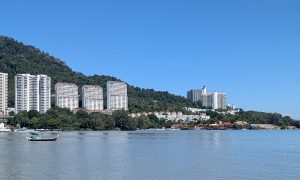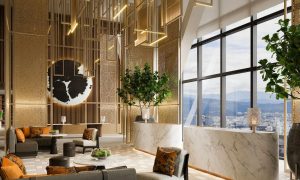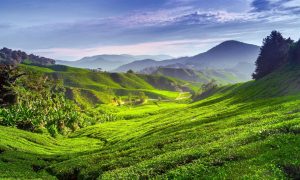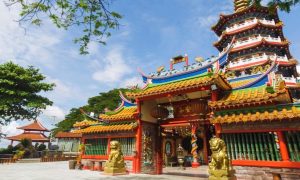Blending Borneo’s indigenous heritage, colonial legacies, and modern-day comforts, Kuching delivers a relaxed and rewarding experience — with culture, cuisine, and nature all within easy reach… and it’s a great base for exploring Sarawak’s other attractions, too.
Visit Malaysia Year 2026 is fast approaching, and so all around the country, travel and tour companies, government tourism offices, and hotels and resorts are racing against the clock to put their best foot forward in welcoming visitors to Malaysia next year. One crucial part of any travel itinerary is ground transportation, and though it’s admittedly not as sexy as business class flights or five-star beachside resorts, getting from point A to B is a critical segment of travel that cannot be ignored.
With this in mind, I recently set out across the South China Sea to embark on a week-long tour of Sarawak with a group of friends. Our plan was to fly in, pick up our private CAM Co-Star minibus (more on that later), and explore Malaysia’s largest state for a few days. Our goal was to see how a small bus like this would work as a tool for making Sarawak more accessible – allowing us to see more, do more, and experience more.
But before we set out into the wild backcountry roads of rural Sarawak, we spent a couple of days getting reacquainted with Kuching, our port of arrival, and a place I hadn’t been since just before the pandemic.
SARAWAK’S CAT CITY
Kuching, the capital of Sarawak, may be a domestic destination, but flying into the city still requires a stop at the immigration counter. It’s a small reminder that Sarawak operates with a fairly significant degree of autonomy from Peninsular Malaysia — and that sense of difference is part of what makes it such a compelling place to visit.

From its meandering riverside paths and easygoing energy to its enduring tribal traditions and multicultural roots, Kuching is a city that invites slow exploration. It’s compact and charming, a place that delivers history and hospitality in equal measure. And there truly is a laid-back friendliness here that’s just a little different from what we experience in Kuala Lumpur! Every time I visit, I get a real sense of that ‘1Malaysia’ ideal that we don’t often feel quite as keenly on the Peninsula. Here, it’s not just an empty slogan; there’s a ‘live and let live’ vibe in Kuching that just infuses the city and people of all stripes just seem to coexist comfortably.
The city’s southern bank is home to the Kuching Waterfront, a scenic 2-km promenade that has become the city’s social heart, for residents and tourists alike. (Since it’s on the river, I’ve always felt it should be called the ‘Kuching Riverfront’ but as is often the case, I wasn’t consulted.)
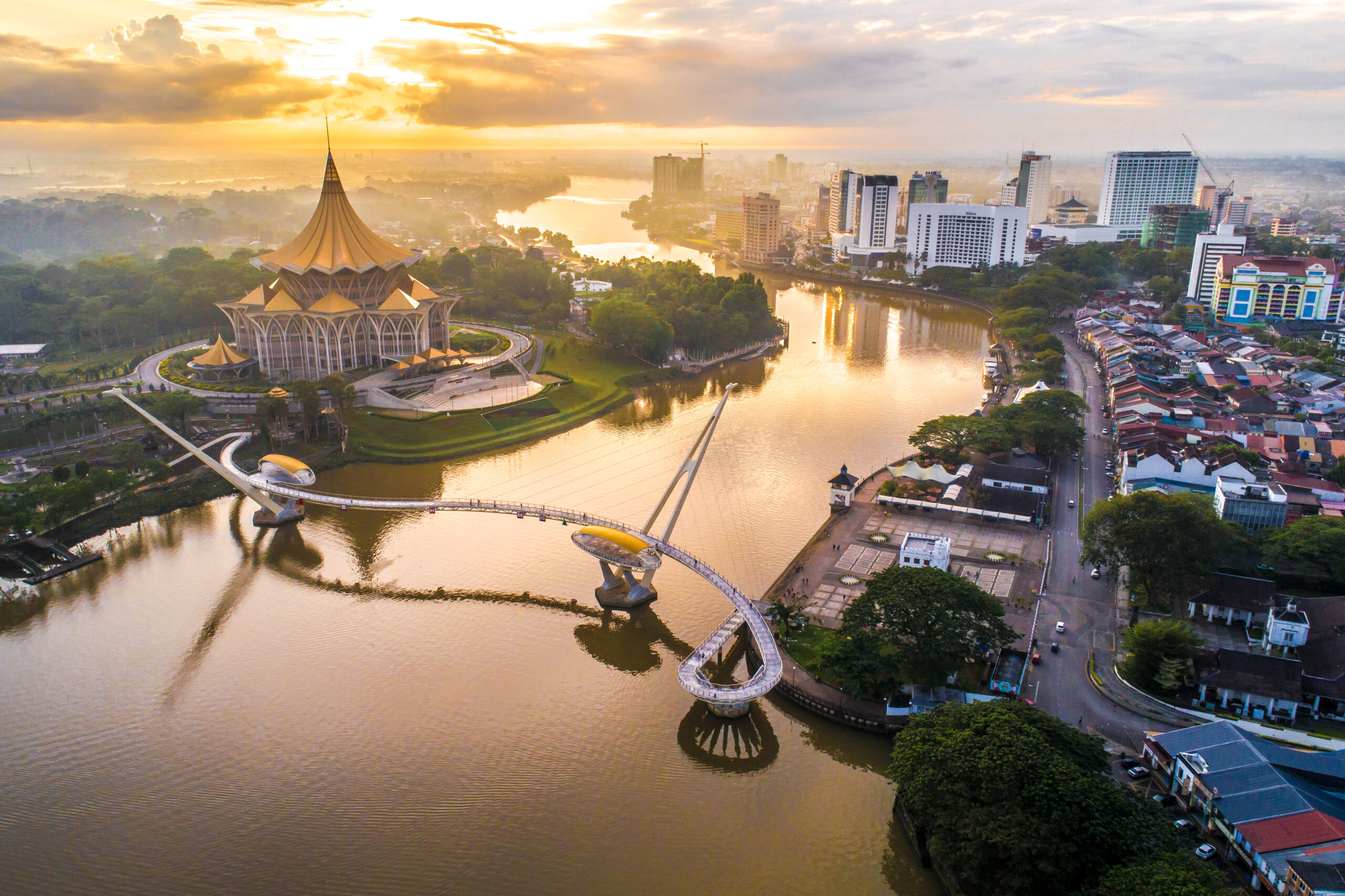
Flanked by landscaped gardens, open-air cafés, public art installations, souvenir shops, and innumerable shops selling Sarawak’s famed kek lapis, the waterfront also leads visitors to historic sites linked to the White Rajahs who once governed Sarawak. Parallel to the promenade is the Main Bazaar, packed with shops selling local carvings, beadwork, textiles, and antiques. For genuine artifacts and furnishings, Johns Gallery at No. 18 is said to be reliable.
One of the most distinctive sights on the Kuching skyline is the soaring golden spire of the State Legislative Assembly (Dewan Undangan Negeri) building, known locally as the DUN building. Set on the north bank of the Sarawak River, the building’s dramatic architecture often divides opinion, but it has undeniably become one of the city’s defining landmarks. Next door is Fort Margherita, built in the 19th century and named after the wife of Charles Brooke, the second White Rajah of Sarawak.
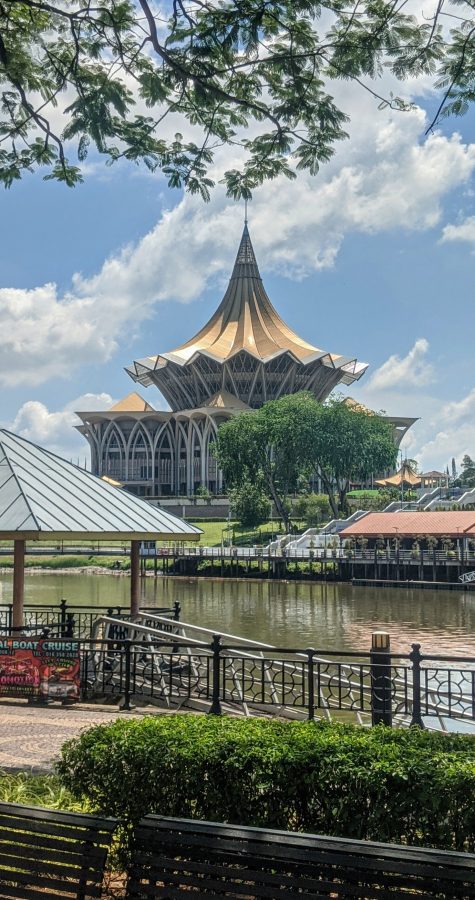
Connecting the two riverbanks is the Darul Hana Bridge, a striking, S-shaped pedestrian suspension bridge. Opened in 2017, the bridge offers panoramic views of both sides of the river and is especially popular at sunset, when the waterfront lights begin to shimmer and boat cruises gently pass beneath. It’s also a practical link for visitors wanting to explore the contrasting vibes of each side of the city.

Though the Kuching Waterfront is plenty appealing, it also has its share of critics who maintain that it could be so much better. As I jogged along the wide paths one morning, I could kind of see that perspective. The river could certainly be cleaner (there’s a lot of floating debris at times), and I personally found the strips of coloured neon lights somewhat randomly affixed to the stately rain trees along the river (and lit up at night) to be rather garish and unnecessary. There is a lot of potential for sustainable, enjoyable tourism use along this long, wide promenade that really does seem to be underutilized. But for me, coming from KL where something even on this level remains a dream (anyone remember the River of Life project?), I still always find the Kuching Waterfront a very enjoyable place to spend some time, even if it’s not living up to its fullest potential.
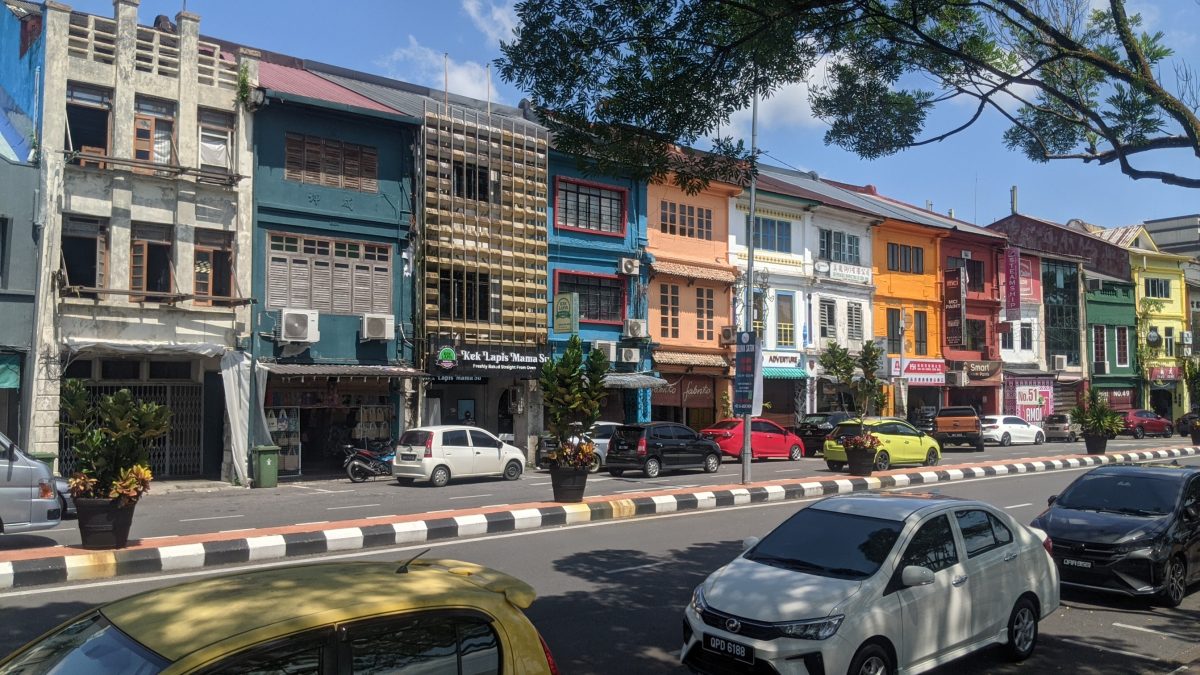
Also worth a stop is the Tua Pek Kong Temple, built in 1843 and still in use today. This temple is widely regarded as the oldest Chinese temple in Sarawak. Situated prominently along the waterfront near the Main Bazaar, the temple is dedicated to the deity Tua Pek Kong, a popular figure in Chinese folk religion known for offering protection and prosperity. This makes the edifice rather more of a ‘temple of the people’ than one that’s strictly a Buddhist temple, as is so often the case.
Tua Pek Kong’s presence is almost impossible to miss as you walk through the area. Its bold red-and-green colour scheme, traditional curved rooflines, and incense-filled interior make it both a place of worship and a cultural landmark. Despite its impressive age, the temple remains active, regularly visited by devotees and tourists alike. Its location on a small hillock is said to have good feng shui, which adherents credit for the temple’s long survival through fires, floods, and wartime bombings that have impacted surrounding areas. For visitors, the temple offers a glimpse into Kuching’s longstanding Chinese community and its enduring spiritual traditions. (And as we learned along the trip, several other cities and towns in Sarawak have Tua Pek Kong temples of their own.)
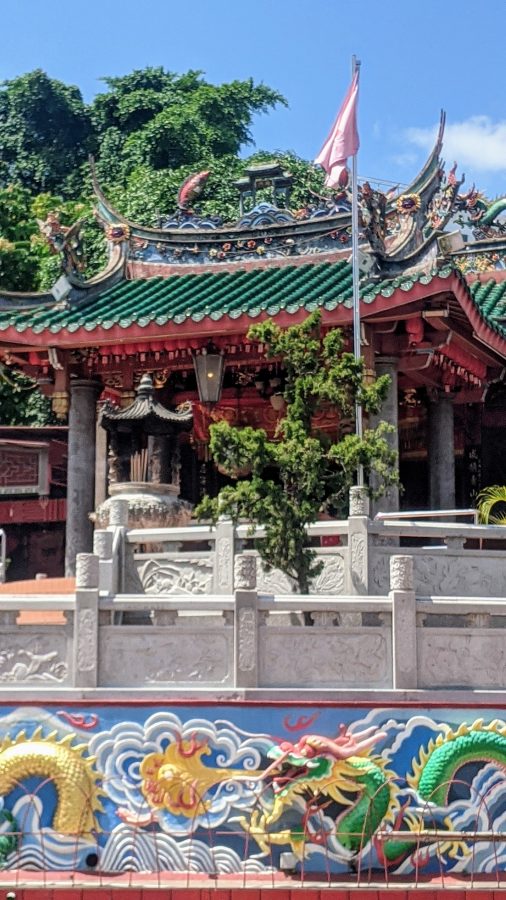
Kuching’s museum scene is anchored by the expansive Sarawak Museum Complex, which includes both a Victorian-era building with traditional exhibits, called the Old Sarawak State Museum (or Ethnology Museum) and a modern wing with curated displays, the Borneo Cultures Museum. Admission is free, and the complex also features a café and a well-stocked souvenir shop.
The old wing was modelled after the Musée de la Ville in Paris, and was built in 1891, having been commissioned by Charles Brooke, the second White Rajah of Sarawak. The museum houses a collection of taxidermy, tribal artifacts, traditional weapons, musical instruments, and numerous ceremonial objects. There’s a certain old-school charm here, and the full-size walk-through model of a traditional longhouse is alone worth the visit. (This part of the museum was closed for a month-long exhibit inventory during our stay, but is expected to reopen in July 2025. Fortunately, this wasn’t my first time to Kuching!)
The newer part of the complex was opened only in March 2022, and it’s the largest museum found anywhere in Malaysia (and the second-largest in Southeast Asia). This facility, called the Borneo Cultures Museum, focuses on Borneo’s indigenous communities, cultural practices, and archaeological history. The overall museum complex, which offers visitors a comprehensive look into Sarawak’s cultural and natural heritage, is widely regarded as one of the region’s finest museums.

Another essential experience is the Satok Weekend Market, which despite its name is actually open daily. (Years ago, the original market was indeed only open on weekends, and the old name just stuck, given the market’s 30-year run before closing and moving to a new location in 2013. The more updated name is Medan Niaga Satok, but many locals still call it the Satok Weekend Market.) From jungle-sourced produce and handmade crafts to grilled snacks and medicinal brews, the market is a one-stop showcase of Sarawak’s diversity. It’s a short taxi ride from the city centre, and now located on the opposite (north) side of the river.

DINING AND DRINKING
Food is an essential part of the Kuching experience. The city’s signature dish is Sarawak laksa — a richly spiced noodle soup topped with prawns, chicken, sliced omelette, and fresh herbs. Another staple here is kolo mee, egg noodles tossed with minced pork, vegetables, and light seasoning. Both dishes are readily available at hawker stalls and local cafés. You’ll also find such treats as pork satay and some excellent pisang goreng (banana fritters) quite easily in parts of Kuching. A particularly famous vendor on Carpenter Street regularly quotes wait times of 30-45 minutes for his coveted pisang goreng. In several visits to Kuching, however, I’ve never felt compelled to queue up and wait that long for banana fritters.
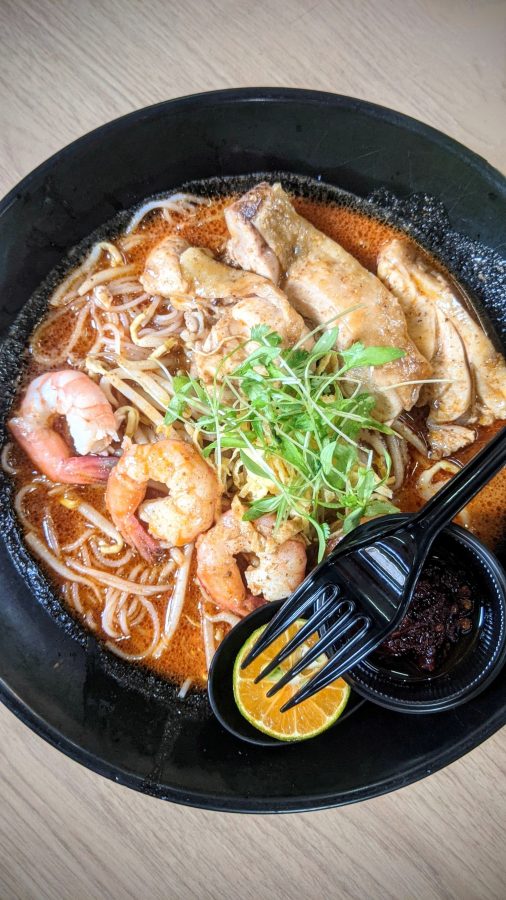
For drinks, tuak — Sarawak’s traditional fermented rice wine — appears in both its original form and creative cocktails. At the Batik Boutique Hotel’s bar, try a tuak margarita, or head to The Junk at 80 Jalan Wayang for a more eclectic setting. This maze of themed bars includes spots like The Red Room, Backstage, and The Hole in the Wall, serving everything from tuak mojitos to their signature 555 Sour. This hot spot has endured since 2002, so we figure they must be doing something right.
The drinking culture in Sarawak is altogether different from that of the Peninsula, mostly in that it’s just not that big a deal. Apart from tuak and its distilled, higher-proof cousin langkau, a wide range of beers are also available, often at prices considerably lower than in KL. What’s more, a handful of locally brewed craft beers are also waiting to be discovered here, perhaps none more prominent than 1602, a Sarawakian range of beers made at Malaysia’s first licensed craft beer brewery, and named after the year in which lager yeast was born, arising from a blend of wheat beer and dark beer yeasts.

CITY STAYS
Accommodation options in Kuching range from budget guesthouses to five-star hotels. Among the top-tier choices is the Pullman Kuching, a centrally located property which began welcoming guests in 2009 with nearly 400 rooms and suites, offering business-class facilities with sweeping city views, especially from its 22nd floor Executive Lounge.
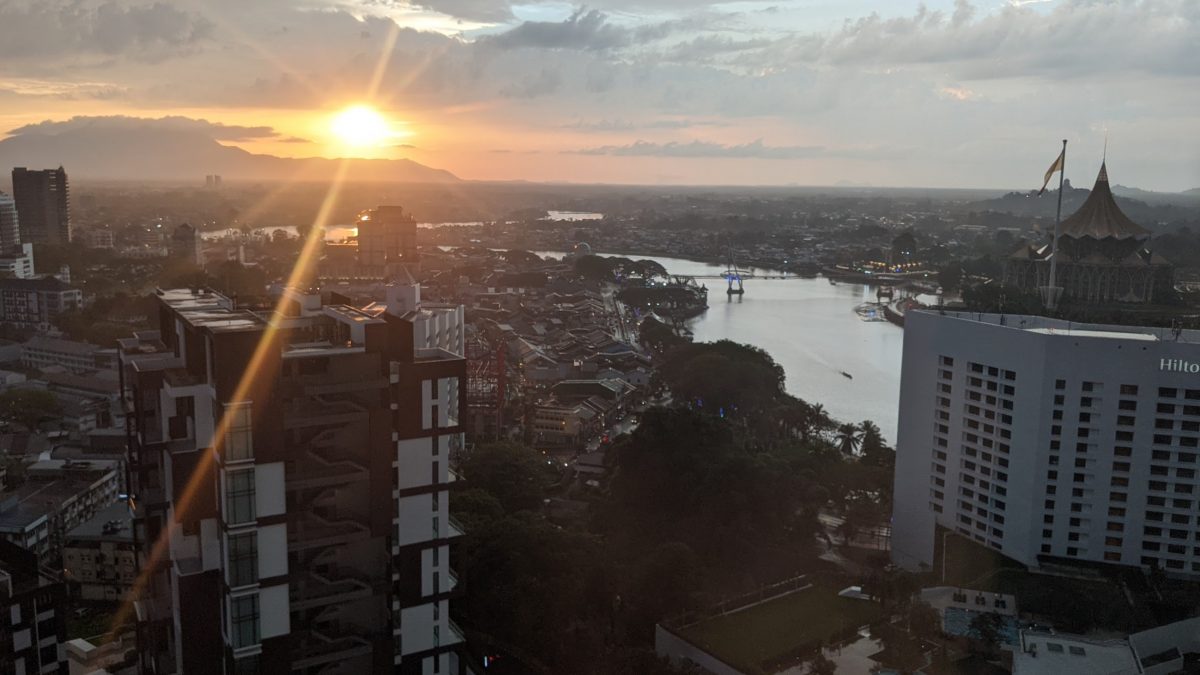
Additionally, Sheraton has a lovely new property nearby (complete with a rooftop pool), and the venerable Hilton Kuching, which opened its doors in 1988 as the city’s first international-standard hotel, still stands sentinel over the Kuching Waterfront. The Hilton underwent a major renovation in 2011 and another smaller one in 2023.
Meanwhile, the Pullman, where we stayed, is undergoing a transformation of its own, a fairly major year-long project (centred primarily on the lobby and other public areas, along with the hotel’s dining outlets) that is presumably meant to be completed to some extent by August 2025, but the state of construction in certain areas made us wonder about that timetable. Though a number of the hotel’s facilities were unavailable during our stay, our rooms on level 18 were still very nice, spacious, and quiet, and we think this will be an easy hotel to recommend once the renovations are fully completed.
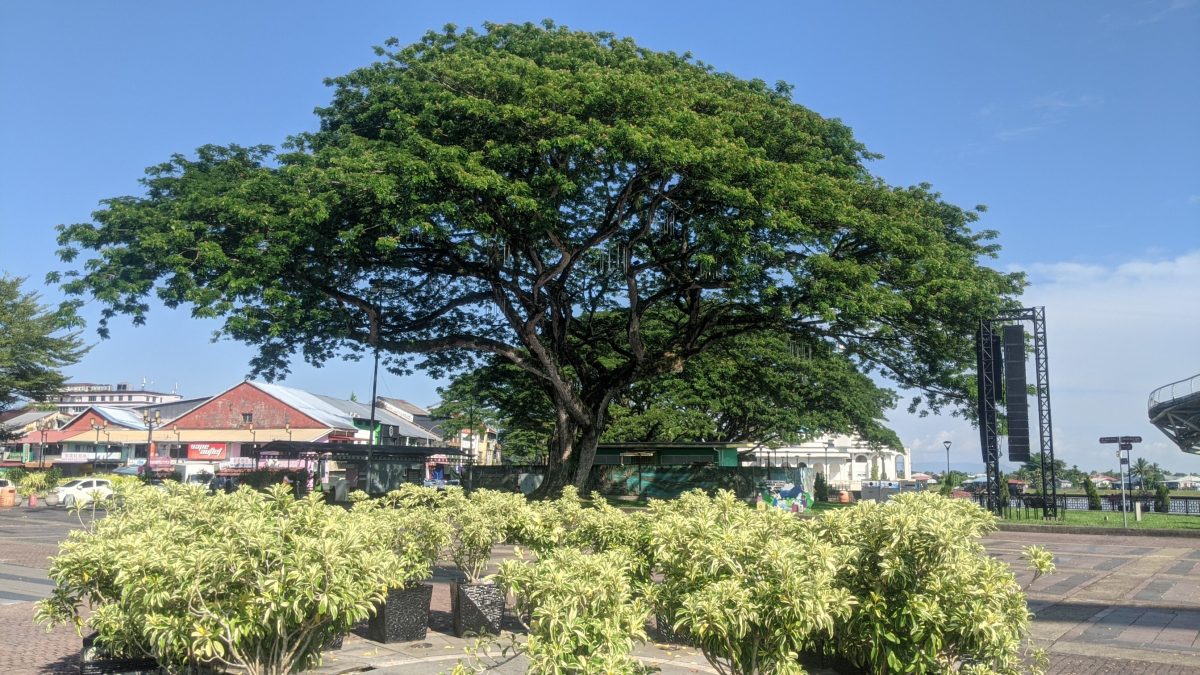
GETTING AROUND
For small groups that won’t fit easily into a car or MPV, a private minibus is an option worth considering. We were lucky to get a nice new CAM Co-Star minibus as our vehicle.
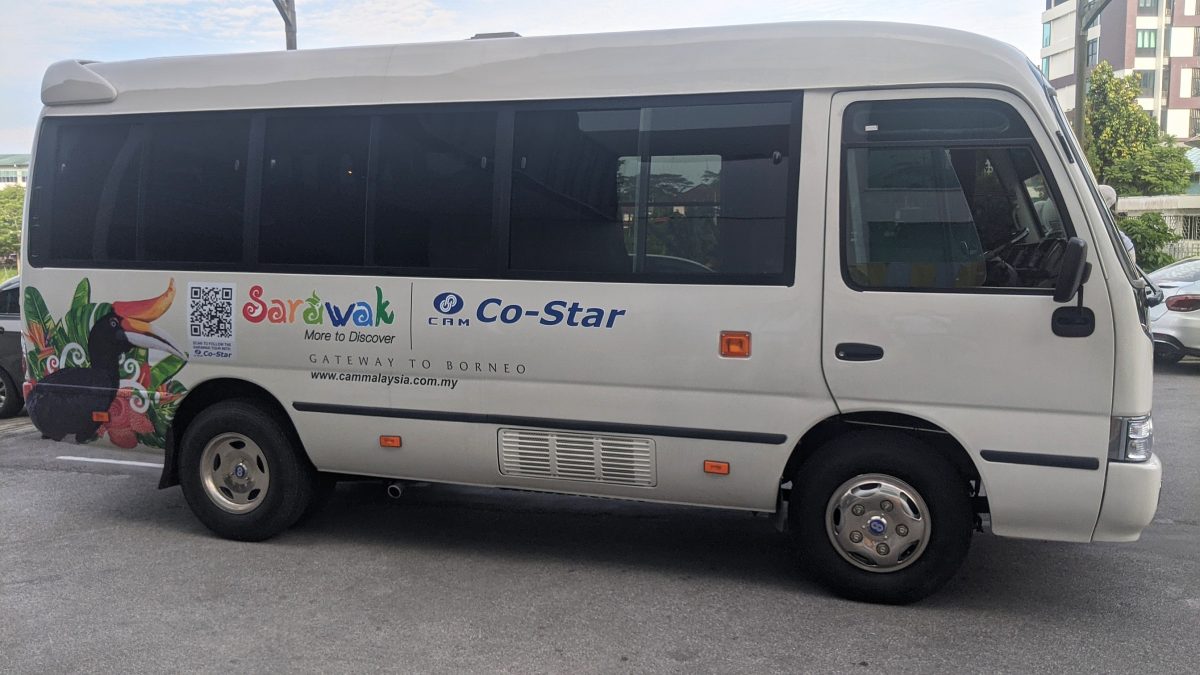
It worked out quite well, because beyond being a great destination in its own right, Kuching also serves as a springboard for adventures further afield. Bako National Park, Semenggoh Wildlife Centre, Damai Beach, and Gunung Gading are all easily accessible. Nature lovers and wildlife seekers will appreciate the orangutan sanctuaries, jungle trails, and varied ecosystems.
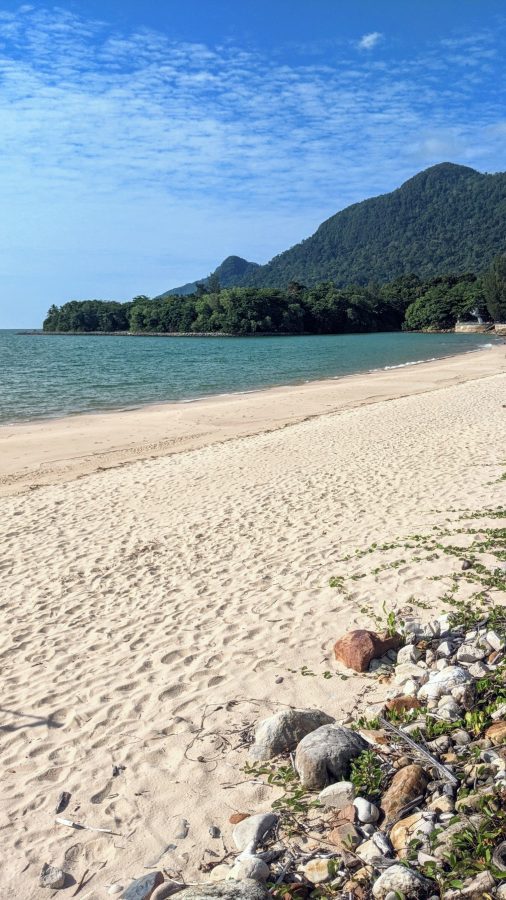
A visit to the Sarawak Cultural Village at Damai, located about 45 minutes from the city, offers a tightly curated yet informative overview of the state’s ethnic groups, all framed by Mount Santubong (which never fails to impress) and the South China Sea. We dropped by, just a couple of days after the iconic Rainforest World Music Festival had been held over a three-day span, and were impressed at how quickly the workers had gotten the grounds back into shape.
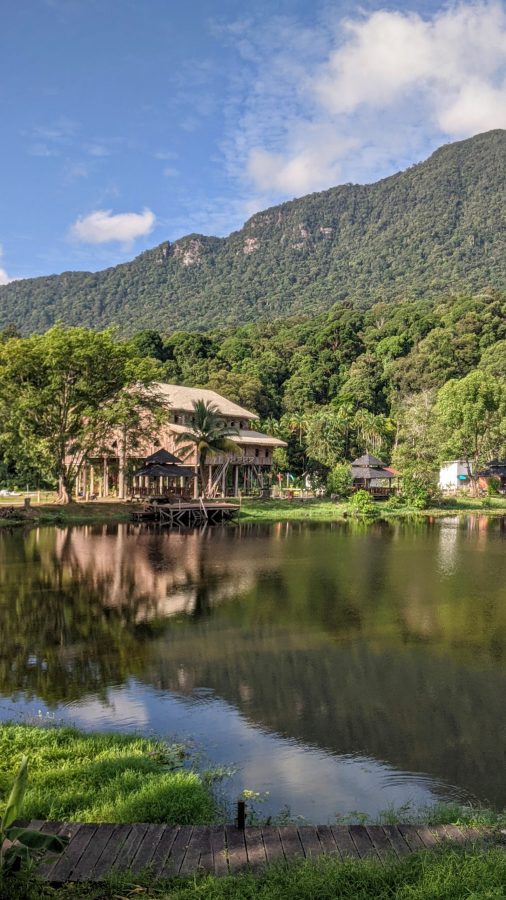
Unfortunately, the Cultural Village, which genuinely is a fine destination for visitors, practices the highly questionable two-tier pricing scheme, with non-Malaysians paying roughly 60% more than locals. As always, we call on tourism players to stop subscribing to this unfair practice, particularly in the run-up to Visit Malaysia Year 2026.
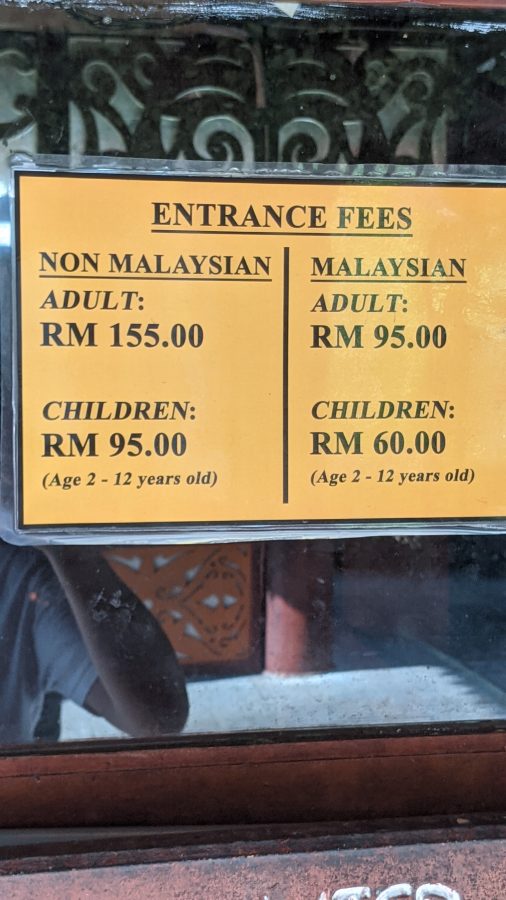
We also stopped by Cove 55, an upmarket boutique resort not far from Damai. Though we didn’t stay at the property, we spent some time exploring the grounds, checking out the lovely villas, and enjoying an outstanding dinner focused heavily on local indigenous Sarawakian cuisine (specifically Iban). The dishes were packed with unfamiliar, alluring flavours and we absolutely loved both the food and the excellent hospitality.
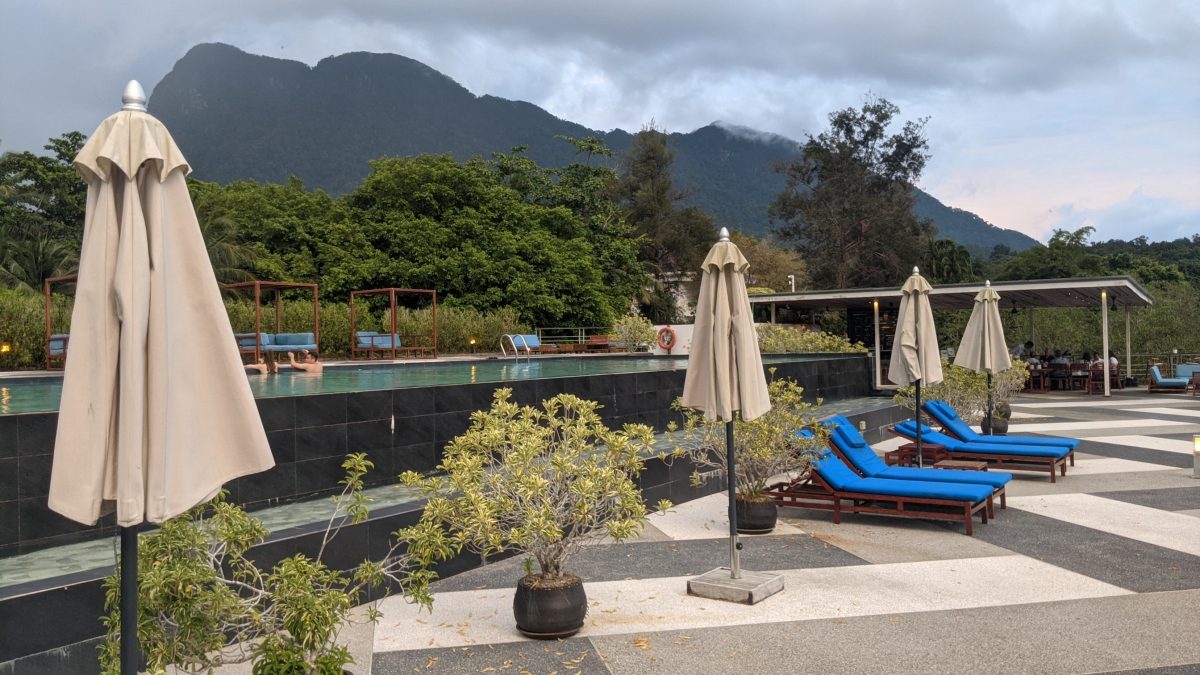

ON THE ROAD
For a road trip across Sarawak with a group of friends, the six-metre CAM Co-Star minibus turned out to be an excellent choice. (There’s an even larger 7.7-m variant, but the smaller one was more than enough for our needs.) Our model carried 19 people plus a driver, though our group was a little under half that – so we had plenty of space! Packing 20 people on the bus would not be advisable for long-distance leisure travelling.
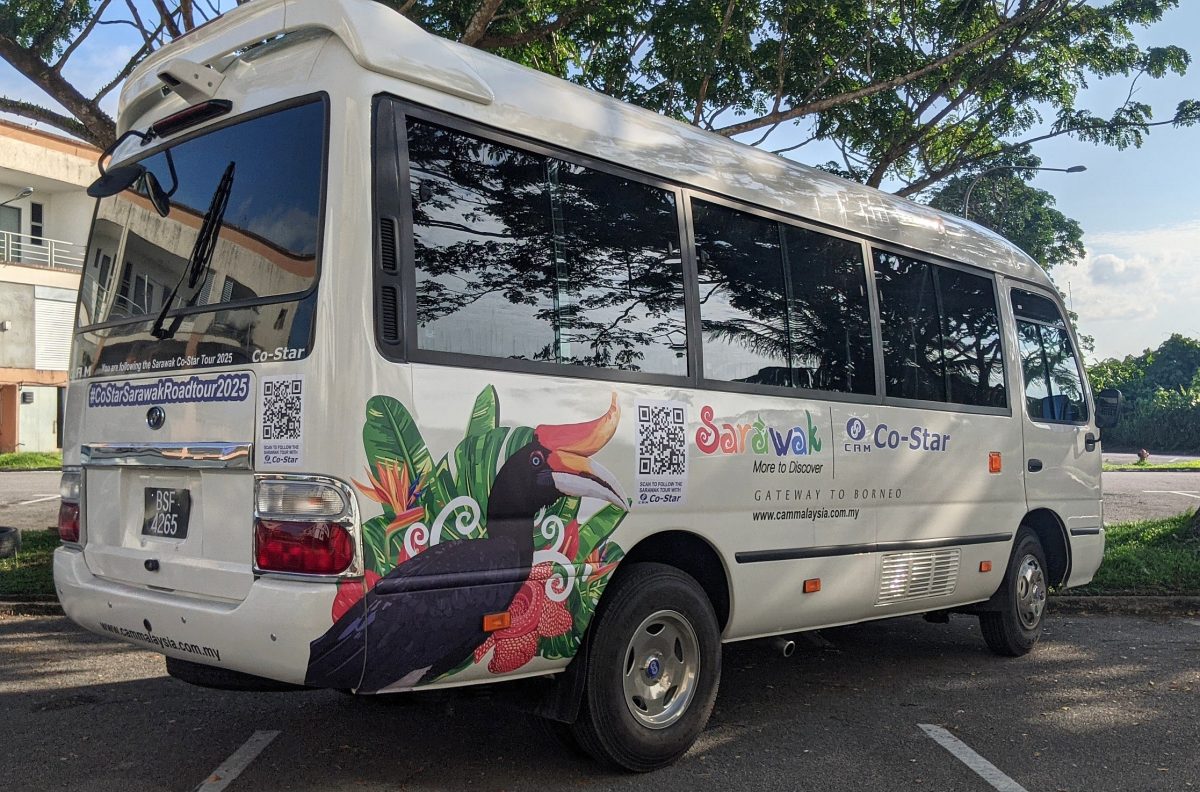
We weren’t entirely sure what to expect at first, but it didn’t take long to appreciate the comfort and practicality it brought to the journey, especially as the Co-Star we got was quite literally brand-new. It’s not a flashy vehicle – what bus is? – but this minibus offered us a fine rolling view of Sarawak and gave us the chance to experience a sizeable part of the much-touted Pan-Borneo Highway. (Our reviews of this road were somewhat mixed, but more on that in a future travel story!)
Though the CAM Co-Star’s seats themselves were rather narrow, the overall interior was spacious enough for everyone in our small group to stretch out a bit, and the automatic sliding door generally made quick stops a lot more manageable. The high roof was definitely a welcome feature for taller folks. As for the ride itself, we thought it was overall pretty quiet and smooth, perhaps except on some of the bumpiest backroads.
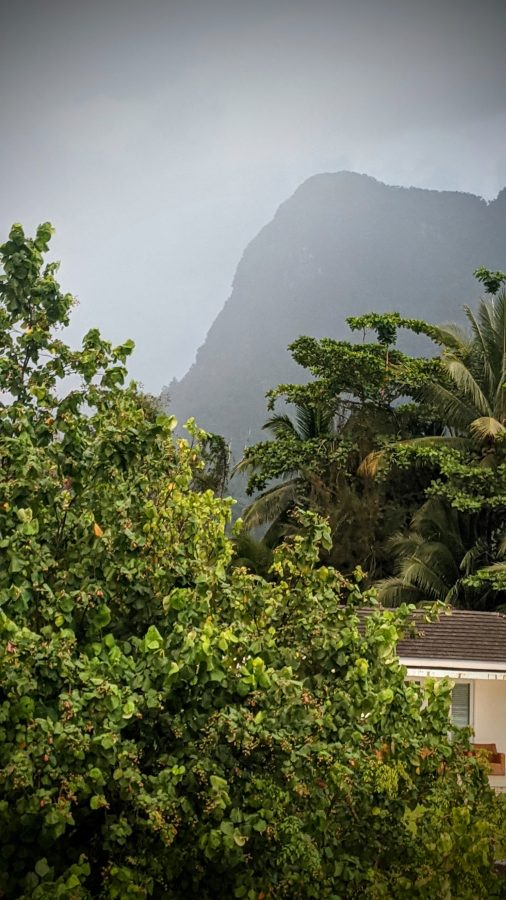
There’s decent luggage space and plenty of large windows, and the air conditioning was cold (thankfully), and though not many in our group were particularly keen on talking engine specs, we all still noticed that the vehicle performed quite well in this regard — the turbocharged diesel engine handled Sarawak’s hillier terrain without complaint and didn’t guzzle fuel at lower speeds (though consumption did creep up as we cruised along at 85-90 kph on the Pan-Borneo Highway). Even as we set out from Kuching, we felt excited by and confident in our “chosen chariot,” which is about the best thing you can say for any tour vehicle.
But the real benefit of such a vehicle is the accessibility it offers visitors who are keen to explore the many wonders of Sarawak. There is so much to see and experience in Malaysia’s largest state, and the CAM Co-Star worked quite well for us. Serving as a private tour vehicle is admittedly not the vehicle’s primary function – it’s angled more towards inter-city transportation, we figured – but despite this, we found it to be a capable and reliable way to enjoy so much of what the amazing state of Sarawak has to offer. More trip reports will be coming soon, so stay tuned!
